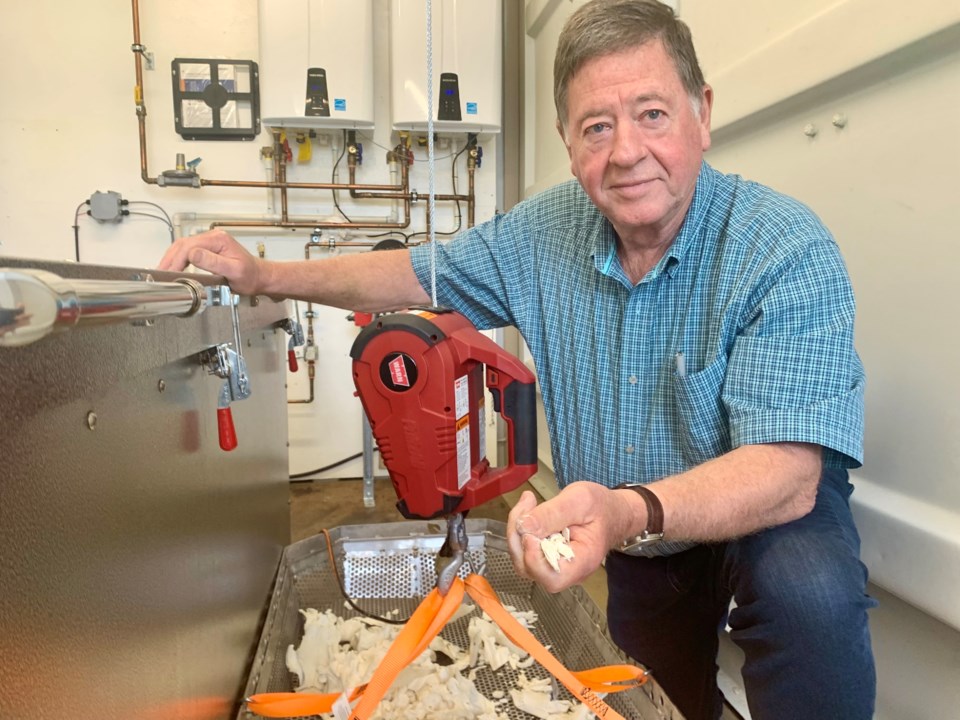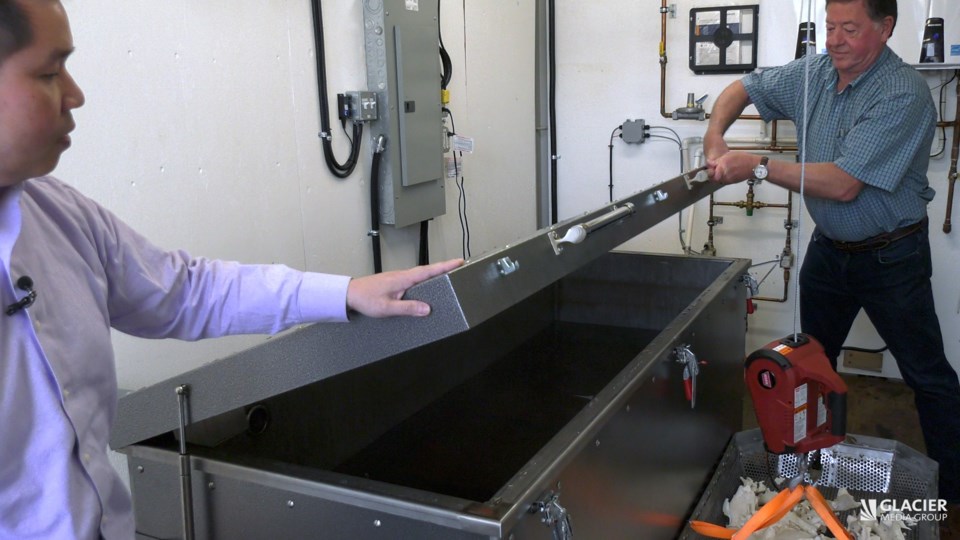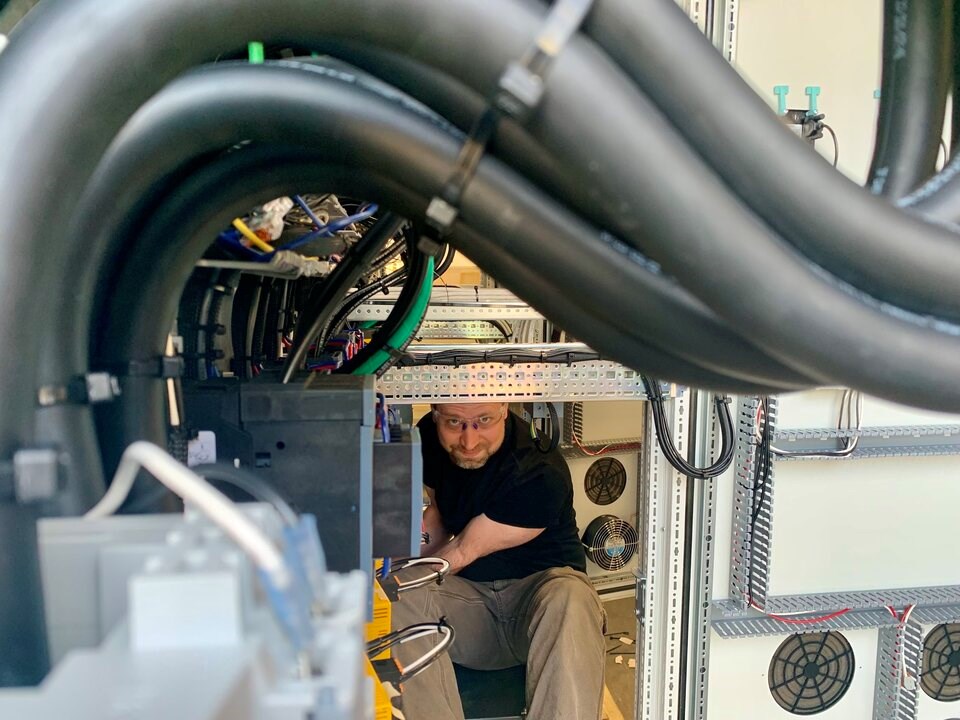Theo Nguyen and Stan Hussey unlatch the doors of a shipping container in a lot behind their Burnaby workshop. Outside, spools of fibre optic cable line a fence. Inside, a slight smell of ammonia hangs in the air.
Nguyen presses a button and several water pumps come on with a whoosh. Bubbling water feeds into what looks like an extra-long chest freezer. But unlike a freezer, this machine is filled with water fitted with several heating elements that raise its temperature above 100 C.
When potassium hydroxide — a major ingredient in soap — is mixed in, the solution can completely dissolve the tissue of a human body in four to eight hours.
Often described as water cremation, the alkaline hydrolysis process is closer to an accelerated burial — the tissue decomposes as if it were buried in the earth, only faster.
The remaining effluent comes out as pure sterilized nutrients, and after its pH is lowered with citric acid, it can be drained directly into the wastewater system. Leftover and chemically altered bones come out so brittle they break apart in your hand and can be kept in an urn, scattered into the ocean or added to soil as fertilizer.
The remains of their most recent test — 16 hog heads — are laid out next to the machine on a metal stretcher hooked up to an overhead winch.
“It comes out pure white,” says Hussey, crushing a piece of hog skull in his hand. “It’s like bone meal you put in your garden.”

From animal remains to humans
Since the 1970s, Hussey’s company, Habourview Electric Ltd., has provided electric control panels for a number of industries, from forestry, mining and buildings to roller-coasters and wastewater systems around the world.
An engineer at the company, Nguyen says he first thought about the water cremation machine shortly after his family got a cat during the COVID-19 pandemic.
Always looking ahead, he thought to himself: What do we do with this animal once it’s dead?
The idea of water cremation for pets was initially supposed to be a project to keep him and his wife busy in retirement, but something he heard one night at his local Toastmasters Club in North Vancouver changed all that. He remembers speaking to fellow member Guy Heywood, a financier who had experience in the funeral industry.
Heywood told the engineer that since veterinarians controlled the pet-disposal market, he’d be better off building something for humans. Heywood ended up joining as one of five partners in the start-up, and helped with a business plan and financing.
After some tinkering, Nguyen came up with a prototype in 2020, dubbing it the “Aqualyser.” While the few other machines on the market look like cryogenic chambers, Nguyen said theirs doesn’t rely on high pressure. That makes it both safer to use and much less intimidating, he said.
“We’re scared of death,” Nguyen said. “Once people can see it and touch it, it’s little more than an electric water heater.”
'A huge positive change,' says funeral home owner
Last year, Nguyen and Hussey began testing the machine on animal remains. So far, those have included pigs, goats, deer and even a black bear found as roadkill near Salmon Arm, where the company eventually hopes to ramp up manufacturing at a retrofitted mill.
The company has yet to pass a human through the Aqualyser, but from a technical point of view, Nguyen says it’s not much different from an animal.
It’s also expected to be cheaper, and not just for grieving families. Whereas a flame crematory could cost a funeral home as much as $500,000 US, the Aqualyser is expected to cost less than $100,000 US.
Hussey, a Coquitlam resident, says that’s half the price of other water-cremation machines on the market.
Several funeral homes in the province have already lined up to stock their facilities with a water-cremation device. Tyrel Burton, owner of Alternatives Funeral Cremation Services, which has several locations around Metro Vancouver, said he is excited to see a local manufacturer push for water cremation, what he describes as a more environmentally friendly alternative.
He cited data that shows every year, the bodies of 90 per cent of people who die in sa国际传媒 are cremated by flame. The process, which every year burns about 30,000 bodies at 1,800 C, releases an estimated 10 million kilograms of carbon into the atmosphere.
“We lead the way with electric cars, for sure, as you can see on the highways, and I think this is just that natural next step to bring this in,” Burton said. “And I think it can be a huge positive change, both environmentally and I think just giving people different options, not just burial or [flame] cremation.”

'No anticipated timeline' to lift legal barriers
One of the biggest hurdles, however, is the fact that sa国际传媒 has not yet authorized water cremation, despite laws legalizing alkaline hydrolysis in Saskatchewan, Ontario, Quebec, Newfoundland and Labrador, the Northwest Territories and about half of U.S. states.
In an email, a spokesperson for the Ministry of Public Safety and Solicitor General said any changes to existing laws governing the disposal of human remains would require engagement within the provincial government, with municipalities and with industry.
The ministry spokesperson said policy work to inform potential future amendments to the is ongoing, but there is “no anticipated timeline for when amendments would be made.”
Hussey said the funeral industry has been asking the government to approve water cremation, but “it’s been hard to get their attention,” which has been frustrating.
If it’s approved, Hussey says water cremation will benefit family-run funeral homes and small towns that might need to process about 200 bodies a year. But the legal delay worries some funeral homes that have recently seen a growing crematoria crunch in the province’s urban areas.
Under air-pollution laws, it’s nearly impossible to build new flame crematoria in Metro Vancouver. As the region’s population grows, many crematoria can’t keep with demand, and some funeral homes have resorted to shipping human remains to Vancouver Island and Washington state to be cremated.
Owners feel pushed out of sa国际传媒 despite anticipated benefits to residents
All the legal wrangling has led Hussey and Nguyen to seek out markets in places like Saskatchewan and Oregon, where water cremation is legal and governments are courting the business to set up shop.
Neither of them want to move the fledgling start-up and both say they would abandon any thoughts of moving the company — not least because staying would mean they could help upend the way people interact with death for the better.
Offering alternatives in death matters for people like Jesus Rodriguez, the panel shop’s foreman, who oversaw much of the plumbing and electrical work for the machine.

鈥婭nside the Burnaby shop, rows of electrical panels more than two metres tall line the room. Rodriguez and his colleagues put the final touches on the electrical brains for the “Master Blaster,” a roller coaster in Saudi Arabia. Other control panels will be used to fill water log rides at amusement parks in Turkey or Germany.
He likes his job, but for Rodriguez, building the water cremation machine hit at something much more personal.
“I’ve seen flame cremation. I had a child pass away at eight months. I had to push the button,” said Rodriguez. “The thought of fire was hard on the soul. It feels hurtful to me.”
“I think this is a softer way to go.”
>>> To comment on this article, write a letter to the editor: [email protected]


